![]()
![]()
![]()
Use LEFT and RIGHT arrow keys to navigate between flashcards;
Use UP and DOWN arrow keys to flip the card;
H to show hint;
A reads text to speech;
111 Cards in this Set
- Front
- Back
|
Describe hormones and explain how hormones are used.
|
The chemical messengers of the endocrine system are called hormones. Hormones circulate to all organs in the body, but a hormone affects only certain tissue cells or organs referred to as its target cell or target organ.
Hormones affect the body's cells by increasing or decreasing the rate of a normal metabolic process rather than by stimulating a new process. |
|
|
Define the term target cell and explain the action of hormones on target cells.
|
a given hormone usually affects only a limited number of cells, which are called target cells. A target cell responds to a hormone because it bears receptors for the hormone.
a particular cell is a target cell for a hormone if it contains functional receptors for that hormone, and cells which do not have such a receptor cannot be influenced directly by that hormone. |
|
|
Explain the methods by which hormones trigger changes in cells.
|
steroidal hormones and thyroid hormone trigger changes in cells.
1. diffuse through plasma membrane of target cells. 2.enter nucleus 3. binds to a specific hormone receptor. 4. binds to specific sites on a cells dna. 5. activate certain genes to transcribe mRNA 6. translated in the cytoplasm, resulting in the synthesis of new proteins. |
|
|
Describe the types of stimuli that can activate endocrine organs.
|
hormonal, humeral, neural.
|
|
|
Describe the major endocrine organs including the pituitary, thyroid, parathyroid, adrenal, pineal, thymus, pancreas, ovaries, and testes; and the hormones produced and/or secreted by each.
|
The major endocrine organs of the body include the pituitary, thyroid, parathyroid, adrenal and pineal glands, thymus, pancreas, and the gonads (ovaries and testes). The pancreas and gonads are mixed glands, performing both exocrine and endocrine functions; whereas the other organs perform only endocrine functions.
|
|
|
Describe the pituitary-hypothalamus relationship.
|
The anterior pituitary gland controls the activity of many other endocrine glands and is often referred to as the master endocrine gland. However, the release of hormones from the anterior pituitary is controlled by releasing and inhibiting hormones produced by the hypothalamus. The hypothalamus also makes two additional hormones, oxytocin and antidiuretic hormone (ADH), which are later released into the blood in response to nerve impulses from the hypothalamus.
|
|
|
Describe how the body responds to stress.
|
the adrenal medulla releases norepinephrine and epinephrine during periods of stress.
|
|
|
Describe the endocrine role of the placenta.
|
The placenta is an organ formed in the uterus of pregnant women. Its role includes serving as the respiratory, excretory, and nutrition-delivery systems for the fetus and also produces several protein and steroid hormones that help to maintain the pregnancy and prepare for the delivery of the baby. During early pregnancy, a hormone called human chorionic gonadotropic HCG) is produced by the developing embryo and then by the fetal segment of the placenta. HCG stimulates the ovaries to continue producing estrogen and progesterone so that the lining of the uterus is not sloughed off in menses. Relaxin, another placental hormone, causes the mother's pelvic ligaments and pubic symphysis to relax and become more flexible which eases birth passage.
|
|
|
Pituitary dwarfism
|
is caused by hyposecretion, or diminished secretion, of GH during childhood. Body proportions are normal, but the person as a whole is very small.
|
|
|
Gigantism
|
is caused by hypersecretion, or excessive secretion, of GH during childhood. It is common for an individual with this condition to reach 8 to 9 feet tall.
|
|
|
Acromegaly
|
occurs when GH is hypersecreted after bone growth has ended. The facial bones, particularly the lower jaw and the bony ridges underlying the eyebrows, enlarge tremendously, as do the feet and hands. Thickening of soft tissues leads to coarse or malformed facial features.
|
|
|
Sterility
|
inability to conceive a child, can result from hyposecretion of FSH or LH.
|
|
|
Diabetes insipidus
|
is caused by hyposecretion of ADH and leads to excessive urine output. Individuals with this condition are continually thirsty and drink huge amounts of water.
|
|
|
Goiter
|
is an enlarged thyroid gland that results when one's diet is deficient in iodine. Without iodine, functional hormones cannot be made.
|
|
|
Cretinism
|
the result of hyposecretion of thyroxine in early childhood. Cretinism results in dwarfism in which adult body proportions remain childlike. The head and trunk are about 1.5 times the length of the legs rather than approximately the same length, as in normal adults. Untreated individuals with cretinism are intellectually challenged. If discovered early, hormone replacement will prevent mental retardation and other signs and symptoms of the deficiency.
|
|
|
Myxedema
|
is the result of hypothyroidism occurring in adults, which is characterized by both physical and mental sluggishness.
|
|
|
Graves' disease
|
is one form of hyperthyroidism and results in a high basal metabolic rate, intolerance of heat, rapid heartbeat, weight loss, nervous and agitated behavior, and a general inability to relax. The thyroid gland also enlarges and the eyes may bulge, or protrude anteriorly (a condition called exophthalmos).
|
|
|
Tetany
|
muscles contracting rapidly in uncontrollable spasms, can result if blood calcium levels fall too low. Neurons become extremely irritable and overactive, rapidly delivering impulses to the muscles. Tetany can be fatal.
|
|
|
Addison's disease
|
the result of a generalized hyposecretion of all the adrenal cortex hormones and is characterized by a peculiar bronze tone of the skin. Because aldosterone levels are low, sodium and water are lost from the body, which leads to problems with electrolyte and water balance which in turn causes muscles to become weak. Shock is also possible.
|
|
|
Hyperaldosteronism
|
the hypersecretion of the outermost cortical area hormones. Excessive water and sodium are retained, leading to high blood pressure and edema. Potassium is lost to such an extent that the activity of the heart and nervous system may be disrupted.
|
|
|
Cushing's syndrome
|
the result of hypersecretion of glucocorticoids and results in a swollen "moon face" and the appearance of a buffalo hump of fat on the upper back. Other common and undesirable effects include high blood pressure, hyperglycemia, weakening of the bones, and severe depression of the immune system.
|
|
|
Masculinization
|
the result of hypersecretion of the sex hormones, regardless of sex. The results are often dramatic in females resulting in a beard and a masculine pattern of body hair.
|
|
|
Diabetes mellitus
|
caused from hyposecretion of insulin and can cause blood sugar levels to dramatically rise. When this happens glucose begins to spill into the urine because the kidney tubule cells cannot reabsorb it fast enough. As glucose flushes from the body, water follows, leading to dehydration. Without insulin, cells cannot use glucose, and fats and even proteins are broken down and used to meet the energy requirements of the body. When large amounts of fats are used for energy instead of sugar, the blood becomes very acidic (acidosis) as keytones appear in the blood.
|
|
|
Acidosis
|
is referred to as ketosis and needs to be corrected as coma or death may result.
|
|
|
Three signs of diabetes mellitus
|
are polyuria or excessive urination, polydipsia or excessive thirst, and polyphagia or hunger.
|
|
|
Insulin resistance
|
mild cases of diabetes mellitus (most type 2, or adult-onset, diabetes) produce insulin, but the insulin receptors are unable to respond to it
|
|
|
Describe the endocrine role of the kidneys.
|
inhibits sodium ion reabsorbtion and renin release.
|
|
|
Describe the endocrine role of the stomach intestine.
|
Stimulates glands to release HCI: hydrochloric acid. Stimulates gastric glands.
|
|
|
Describe the endocrine role of the heart.
|
Stretching of atria in heart. Adrenal Cortex inhibits secretion of aldosterone, decreasing blood volume and pressure.
|
|
|
Exocrine glands
|
release their products at the body's surface or into body cavities through ducts.
|
|
|
endocrine glands
|
are ductless glands with a rich blood supply.
|
|
|
Hypothalamus
|
is part of the nervous system, is also recognized as a major endocrine organ because it produces several hormones.
|
|
|
Pituitary Gland
|
has two lobes, the anterior pituitary which is glandular tissue, and the posterior pituitary which is nervous tissue. The pituitary gland secretes the following hormones: Growth hormone (GH) and Prolactin (PRL).
|
|
|
Growth hormone (GH)
|
is a hormone that targets the skeletal muscles and long bones of the body and plays an important role in determining body size.
|
|
|
Prolactin (PRL)
|
is a hormone that targets the breast after childbirth that stimulates and maintains milk production.
|
|
|
The gonadotropic hormones, including follicle-stimulating hormone (FSH) and luteinizing hormone (LH)
|
regulate the hormonal activity of the testes and ovaries.
|
|
|
Posterior Pituitary
|
The posterior pituitary gland does not make the hormones it releases; it simply acts as a storage area for hormones made by hypothalamic neurons including oxytocin and antidiuretic hormone. The posterior pituitary secretes the following hormones: Oxytocin and Antidiuretic hormone (ADH).
|
|
|
Oxytocin
|
is released in significant amounts during childbirth and in nursing women. It stimulates powerful contractions of the uterine muscles (positive feedback mechanism) and causes milk ejection in nursing women.
|
|
|
Antidiuretic hormone (ADH)
|
causes the kidneys to reabsorb water from urine. As a result, urine volume decreases and blood volume increases.
|
|
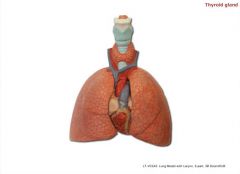
Thyroid Gland
|
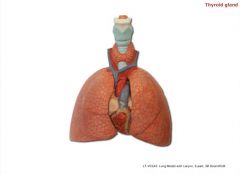
Composed of 2 lobes joined by a central mass or isthmus. It is located in the throat just inferior to the Adam's apple.
The thyroid gland makes two hormones, thyroid hormone and calcitonin. |
|
|
Thyroid hormone
|
Active hormones T4+T3. Controls the rate of metabolism and cellular oxidation.
At which glucose is oxidized and converted to body heat and energy. |
|
|
Calcitonin
|
decreases blood calcium levels by causing calcium to be deposited in the bones. It is released in the blood in response to increasing levels of blood calcium.
Acts antagonistically to parathyroid hormone, the normal product of the parathyroid glands. |
|
|
Parathyroid Glands
|
Parathyroid glands secrete parathyroid hormone (PTH) which regulates calcium in the blood. When blood calcium levels drop below a certain level, the parathyroids release PTH, which stimulates bone destruction cells that break down bone matrix and release calcium into the blood.
|
|
|
Adrenal Glands
|
The adrenal glands are located over the top of the kidneys. These glands are structurally and functionally two endocrine organs in one with a glandular (cortex) and neural tissue (medulla) parts. The adrenal medulla is enclosed by the adrenal cortex which contains three separate layers.
|
|
|
Adrenal Cortex
|
The adrenal cortex produces three major groups of steroid hormones which are collectively called corticosteroids. These include mineralocorticoids, glucocorticoids, and sex hormones. The mineralocorticoids, mainly aldosterone, are important in regulating the mineral content of blood. The middle cortical layer produces glucocorticoids, which include cortisone and cortisol. Glucocorticoids promote normal cell metabolism and help the body to resist long-term stressors, primarily by increasing blood glucose levels. The adrenal cortex also produces male and female sex hormones in small amounts in the innermost layer of the cortex including androgens (male sex hormones) and some estrogens (female sex hormones).
|
|
|
Adrenal Medulla
|
The adrenal medulla develops from a knot of nervous tissue. When the medulla is stimulated by sympathetic nervous system neurons, its cells release two similar hormones, epinephrine or adrenaline, and norepinephrine noradrenaline) into the bloodstream. Collectively these hormones are called catecholamines. When an individual is threatened physically or emotionally, the sympathetic nervous system brings about the "fight-or-flight" response to help cope with the situation. The adrenal medulla is then stimulated to release its hormones into the bloodstream. The catecholamines increase heart rate, blood pressure, and blood glucose levels and dilate the small passageways of the lungs. These events result in more oxygen and glucose in the blood and a faster circulation of blood to the body organs. The catecholamines of the adrenal medulla prepare the body to cope with a short-term stressor.
|
|
|
Pancreatic Islets
|
The pancreatic islets, or the islets of Langerhans, are little masses of hormone-producing tissue within the pancreas. The hormones produced by the islet cells are insulin and glucagon. High levels of glucose in the blood stimulate the release of insulin. Insulin increases the ability of cells in the body to transport glucose across their plasma membranes where it is oxidized for energy, or converted to glycogen or fat for storage. Glucagon is released when low blood levels of glucose are detected. Its primary target is the liver, and it stimulates the liver to break down stored glycogen to glucose and to release the glucose into the blood.
|
|
|
Pineal Gland
|
The pineal gland secretes melatonin. Melatonin plays an important role in establishing the body's day-night cycle. Peak levels occur at night and cause drowsiness; the lowest levels occur during daylight around noon. Melatonin also helps coordinate the hormones of fertility and to inhibit the reproductive system until adult body size has been reached.
|
|
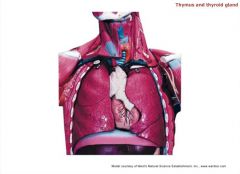
Thymus
|
The thymus produces a hormone called thymosin that is essential for normal development of a special group of white blood cells and immune response.
|
|
|
Gonads: Female
|
or ovaries, produce two groups of steroid hormones, estrogens and progesterone. Estrogens are responsible for the development of sex characteristics in women and the appearance of secondary sex characteristics at puberty. Acting with progesterone, estrogens promote breast development and cyclic changes in the uterine lining (the menstrual cycle).
|
|
|
Gonads: Male
|
The paired oval testes of the male produce male sex cells, or sperm, and male sex hormones, or androgens Testosterone is the most important. At puberty, testosterone promotes the growth and maturation of the reproductive system organs to prepare the young man for reproduction. Testosterone also causes the male's secondary sex characteristics to appear and stimulates the male sex drive.
|
|
|
Gonadotropins
|
Luteinizing hormone (LH) and follicle-stimulating hormone (FSH) are called gonadotropins because stimulate the gonads - in males, the testes, and in females, the ovaries. They are not necessary for life, but are essential for reproduction. These two hormones are secreted from cells in the anterior pituitary called gonadotrophs. Most gonadotrophs secrete only LH or FSH, but some appear to secrete both hormones.
|
|
|
Follicle-stimulating hormone (FSH)
|
A follicle-stimulating hormone test measures the amount of follicle-stimulating hormone (FSH) in a blood sample. FSH is produced by the pituitary gland.
In women, FSH helps control the menstrual cycle and the production of eggs by the ovaries. The amount of FSH varies throughout a woman's menstrual cycle and is highest just before she releases an egg (ovulates). In men, FSH helps control the production of sperm. The amount of FSH in men normally remains constant. |
|
|
Luteinizing hormone (LH)
|
A luteinizing hormone test measures the amount of luteinizing hormone (LH) in a sample of blood or urine. LH is produced by the pituitary gland.
In women, LH helps regulate the menstrual cycle and egg production (ovulation). The level of LH in a woman's body varies with the phase of the menstrual cycle. It increases rapidly just before ovulation occurs, about midway through the cycle (day 14 of a 28-day cycle). This is called an LH surge. Luteinizing hormone and follicle-stimulating hormone levels rise and fall together during the monthly menstrual cycle. In men, LH stimulates the production of testosterone, which plays a role in sperm production. |
|
|
Adrenocorticotropic hormone (ACTH)
|
ACTH is made in the pituitary gland in response to the release of another hormone, called corticotropin-releasing hormone (CRH), by the hypothalamus. In turn, the adrenal glands then make a hormone called cortisol, which helps your body manage stress. Cortisol is needed for life, so its levels in the blood are closely controlled. When cortisol levels rise, ACTH levels normally fall. When cortisol levels fall, ACTH levels normally rise.
|
|
|
Thyrotropic hormone (TSH)
|
TSH causes the thyroid gland to make two hormones: triiodothyronine (T3) and thyroxine (T4). T3 and T4 help control your body's metabolism.
Triiodothyronine (T3) and thyroxine (T4) are needed for normal growth of the brain, especially during the first 3 years of life. A baby whose thyroid gland does not make enough thyroid hormone (congenital hypothyroidism) may, in severe cases, be mentally retarded. Older children also need thyroid hormones to grow and develop normally. |
|
|
Epinephrine
|
Epinephrine, more commonly known as adrenaline, is a hormone secreted by the medulla of the adrenal glands. Strong emotions such as fear or anger cause epinephrine to be released into the bloodstream, which causes an increase in heart rate, muscle strength, blood pressure, and sugar metabolism. This reaction, known as the “Flight or Fight Response” prepares the body for strenuous activity. In medicine epinephrine is used chiefly as a stimulant in cardiac arrest, as a vasoconstrictor in shock, and as a bronchodilator and antispasmodic in bronchial asthma. Epinephrine is found in small amounts in the body and is essential for maintaining cardiovascular homeostasis because of its ability to divert blood to tissues under stress.
|
|
|
Norepinephrine
|
is a
catecholamine with multiple roles including as a hormone and a neurotransmitter. [5] As a stress hormone, norepinephrine affects parts of the brain where attention and responding actions are controlled. Along with epinephrine, norepinephrine also underlies the fight-or-flight response, directly increasing heart rate, triggering the release of glucose from energy stores, and increasing blood flow to skeletal muscle. Norepinephrine can also suppress neuroinflammation when released diffusely in the brain from the locus ceruleus. [6] |
|
|
Corticosteroids
|
Corticosteroids are a type of steroid. Steroids are hormones that are made in the body.
|
|
|
Mineralocorticoids
|
any of the group of corticosteroids, principally aldosterone, primarily involved in the regulation of electrolyte and water balance through their effect on ion transport in epithelial cells of the renal tubules, resulting in retention of sodium and loss of potassium.
|
|
|
Aldosterone
|
the major mineralocorticoid hormone secreted by the adrenal cortex. It promotes the retention of sodium and bicarbonate, the excretion of potassium and hydrogen ions, and the secondary retention of water. Large excesses can invoke plasma volume expansion, edema, and hypertension.
|
|
|
Glucocorticoids
|
Any of a group of hormones (like cortisone) that influence many body functions and are widely used in medicine, such as for treatment of rheumatoid arthritis inflammation.
|
|
|
Estrogens
|
Hormones produced by the ovaries, the female sex glands.
|
|
|
Progesterone
|
the principal progestational hormone liberated by the corpus luteum, adrenal cortex, and placenta, whose function is to prepare the uterus for the reception and development of the fertilized oocyte by inducing transformation of the endometrium from the proliferative to the secretory stage; used as a progestational agent in the treatment of dysfunctional uterine bleeding and abnormalities of the menstrual cycle, as part of postmenopausal hormone replacement therapy, as a test for endogenous estrogen production, and as an adjunct in infertility therapy.
|
|
|
Testosterone
|
the principal androgenic hormone, produced by the interstitial (Leydig) cells of the testes in response to stimulation by the luteinizing hormone of the anterior pituitary gland; it is thought to be responsible for regulation of gonadotropic secretion, spermatogenesis, and wolffian duct differentiation. It is also responsible for other male characteristics after its conversion to dihydrotestosterone. In addition, testosterone possesses protein anabolic properties
|
|
|
Negative feedback mechanisms
|
are the chief means of regulating the levels of nearly all hormones in the blood. The stimuli that activate the endocrine organs can be hormonal, humoral, and neural.
|
|
|
Hormonal stimulus
|
the most common and occurs when endocrine organs are prodded into action by other hormones.
|
|
|
Humoral stimulus
|
occurs when changing levels of certain ions and nutrients stimulate hormone release.
|
|
|
Neural stimulus
|
is rare and occurs when nerve fibers stimulate hormone release.
|
|
|
The endocrine system
|
is the second great controlling system of the body. Along with the nervous system, it coordinates and directs the activity of the body's cells. Unlike the nervous system that uses nerve impulses for immediate action, the endocrine system acts more slowly and uses chemical messengers that are released into the blood or lymph system to be transported throughout the body. The endocrine system controls continuous processes such as growth and development, reproduction, and metabolism. The study of hormones and endocrine organs is called endocrinology.
|
|
|
Location of the major endocrine organs of the body
|
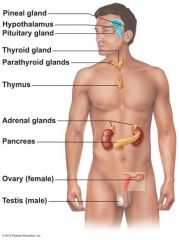
|
|
|
A) Hormonal Stimulus
B) Humoral Stimulus C) Neural Stimulus |
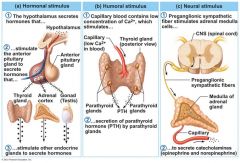
|
|
|
Hormones released by the posterior lobe of the pituitary and their target organs
|
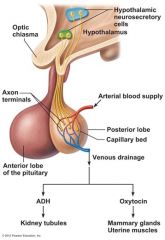
|
|
|
Roles of the hypothalamus, adrenal medulla, and adrenal cortex in the stress response
|

|
|
|
Regulation of blood glucose levels by a negative feedback mechanism involving pancreatic hormones
|
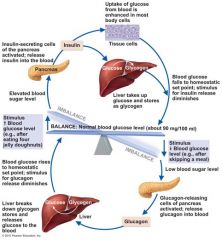
|
|
|
The anterior pituitary has sometimes been called a master gland?
|
True. It's removal or destruction has a dramatic effect on the body. The adrenal gland and thyroid glands, and gonad glands atrophy and results of hypo-secretion by those glands quickly become obvious. It is not all powerful because the hypothalamus controls release and inhibiting hormones.
|
|
|
Glucagon
|
is a peptide hormone, produced by alpha cells of the pancreas, that raises blood glucose levels. The pancreas releases glucagon when blood sugar levels fall too low.
|
|
|
Insulin
|
lowers blood glucose levels.
|
|
|
Both endocrine and exocrine glands.
|
The pancreas and gonads.
|
|
|
Purely endocrine glands.
|
The anterior pituitary, thyroid, adrenals, parathyroids.
|
|
|
Pituitary gland
|
is located in the sella turcica of the sphenoid bone. It has 2 functions: posterior= nervous tissue and anterior= glandular tissue.
|
|
|
Posterior Pituitary
|
is not an endocrine gland because it does not produce the hormones it releases.
It stores 2 hormones transported from the hypothalamus: oxytocin and ADH. |
|
|
Anterior pituitary
|
adenohypophysis, secretes a number of hormones. 4 are tropic hormones.
|
|
|
Tropic hormones
|
stimulate target organs that are also endocrine glands, to secrete their hormones. Target organs then produce their effects on the body and tissues.
They include: gonadotropins ( FSH, LH) ACTH adrenocorticotopic TSH thyrotropic |
|
|
Hormones of anterior pituitary that are not directly involved in the regulation of other endocrine glands
|
GH: Growth hormone
PRL: Prolactin |
|
|
Portal circulation
|
connects the blood supplies of the hypothalamus and anterior pituitary.
|
|
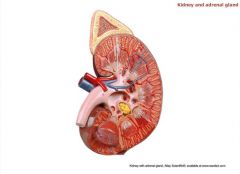
Kidney and Adrenal Glands
|
Adrenal Glands:
Adrenal medulla Epinephrine Norepinephrine Adrenal cortex Corticosteroids Mineralocorticoids Aldosterone Glucocorticoids Gonadocorticoids or sex hormones |
|
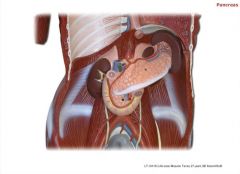
Pancreas
|
Both endocrine and exocrine gland. Located partially behind the stomach in the abdomen. Produces digestive enzymes, insulin and glucagon.
Pancreas: Insulin Glucagons Microscopic Structure Pancreatic islets/islets of Langerhans |
|
|
Hormonal Stimulus
|
The most common stimulus, which endocrine organs are prodded into action by other hormones.
|
|
|
Humoral Stimulus
|
Changing blood levels of certain ions and nutrients may also stimulate hormone release.
|
|
|
Neural Stimulus
|
Nerve fibers stimulate hormone release and the target cells are said to respond to neural stimuli.
|
|
|
Basal metabolism hormone
|
T4/T3 : thyroid gland
|
|
|
t4/t3
|
T3 and T4 is a hormone from the thyroid gland, which is the metabolism center. Those are the hormones that control how slow or fast your metabolism goes. If there is less T3 and T4, your metabolism goes down because there aren't enough hormones to make it go the normal rate. Vice versa, if you have too much, your metabolism goes faster.
|
|
|
Helps program the immune system
|
thymosin : thyroid gland
|
|
|
Regulate blood calcium levels;
|
calcitonin, thyroid gland and PTH, parathyroid gland or PTH, parathyroid gland and calcitonin, thyroid gland
|
|
|
Released in response to stressors
|
epinephrine, adrenal medulla and cortisone, adrenal cortex
or cortisone, adrenal cortex and epinephrine, adrenal medulla |
|
|
Drives development of secondary sexual characteristics?
|
Estrogen / Ovaries
Testosterone / Testes |
|
|
Regulate the function of another endocrine gland?
|
LH/anterior pituitary AND TSH/anterior pituitary AND ACTH/ anterior pituitary AND FSH/anterior pituitary.
|
|
|
Mimics the sympathetic nervous system?
|
Insulin / Pancreas
Glucagon / Pancreas |
|
|
Directly responsible for regulating the menstrual cycle?
|
Estrogens, ovaries and progesterone, ovaries or progesterone, ovaries and estrogens, ovaries
|
|
|
Helps maintain salt and water balance in the body fluid?
|
Aldosterone / Adrenal cortex
ADH / Hypothalamus |
|
|
Involved in milk ejection?
|
Prolactin / Hypothalamus
|
|
|
Located in the throat; bilobed gland connected by an isthmus?
|
Thyroid
|
|
|
Found close to the kidney?
|
Adrenal
|
|
|
A mixed gland, located close to the stomach and small intestine?
|
Pancreas
|
|
|
Paired glands suspended in the scrotum?
|
Testes
|
|
|
Ride "horseback" on the thyroid gland?
|
Parathyroid
|
|
|
Found in the pelvic cavity of the female, concerned with ova and female hormone production?
|
Ovaries
|
|
|
Found in the upper thorax overlying the heart; large during youth?
|
Thymus
|
|
|
Found in the roof of the third ventricle?
|
Pineal
|
|
|
Define Hormone
|
A hormone is a chemical messenger secreted by endocrine glands. They are responsible for specific regulatory effects on certain parts or organs.
|

